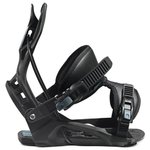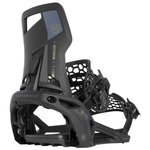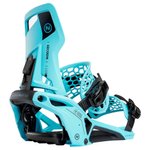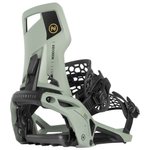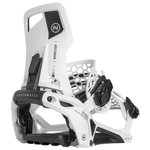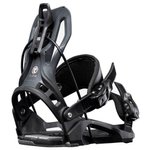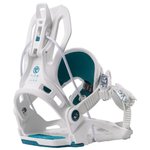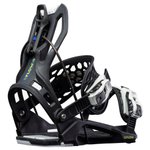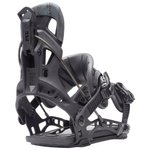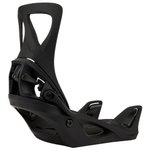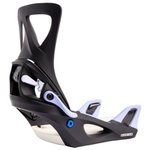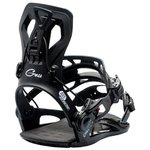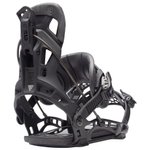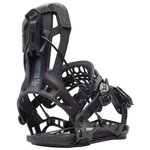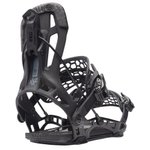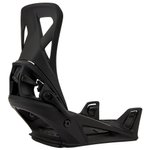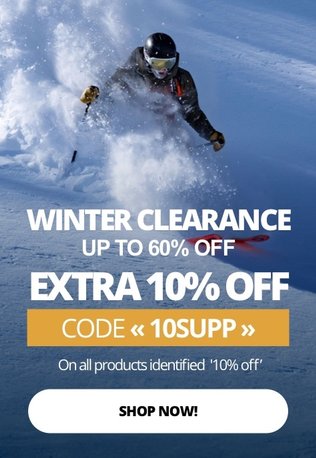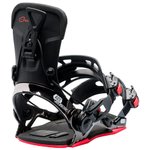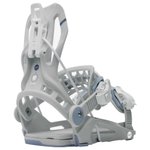Speed-entry snowboard bindings
Looking for new rear-entry bindings?
Then you're in the right place. Our selection below incorporated all our speed entry bindings. This type of bindings allows you to step into the binding from the rear. The highback drops like a gate, lets you in, and goes back up. You can get in in seconds. Rear entry binders will save you time and energy!
Read more Show less

Recommended price
£181.91
-25%
£136.41
The Nexus Black snowboard binding is the new entry level binding from Flow, offering tolerance, Comfort and equipped with a lighter base and of course a very practical rear entry system.
- L (41-45)
- XL (44.5-49.5)


- £409.41
The Nidecker Supermatic snowboard binding features a quick entry system that allows to be always ready to shred. A binding for intermediate or advanced level versatile riders.
- M (37-41)
- L (41.5-44)


Recommended price
£181.91
-25%
£136.41
The Juno Black model from Flow Snowboards is a new quick binding for women riders, offering lightness, Comfort and tolerance for smooth progression throughout the resort.
- S (32-37)


Recommended price
£154.61
-25%
£115.93
The Micron Youth Black is a fast Flow snowboard binding for young riders, offering lots of Comfort in use as well as a good margin for progression in the whole resort.
- S (32-37)
- M (36-41.5)


Recommended price
£391.21
-25%
£293.38
The Flow NX2 Black snowboard binding offers exceptional precision, responsiveness and cushioning, ideal for snowboarders looking to ride with power and comfort on every terrain.
- M (36-41.5)
- XL (44.5-49.5)


Recommended price
£309.31
-15%
£262.90
The Burton Step-On Women Black is a women's snowboard binding offering a lot of practicality and comfort thanks to its strapless system, while remaining reactive and performant.
- S (35-36.5)
- M (37-40.5)
- L (41-43)


Recommended price
£309.31
-35%
£201.02
- S (35-36.5)


- £409.41
The Nidecker Supermatic White is an innovative snowboard binding with an ultra-fast automatic entry system, ideal for intermediate or advanced level riders and for all-mountain freeriding.
- M (37-41)


Recommended price
£209.21
-30%
£146.42
The GNU Cheeter Black is a versatile, functional, and forgiving entry-level snowboard binding, perfect for beginners with its quick strap system and supportive high back.
- M (39-42)
- L (42-44)
- XL (44-48)


Recommended price
£391.21
-25%
£293.38
The Flow NX2 Hybrid Black snowboard binding features the NX2 baseplate for optimal power transfer. It is ideal for carving and all-mountain riding, offering control, responsiveness and comfort.
- XL (44.5-49.5)


Recommended price
£318.41
-25%
£238.78
The Flow NX2 TM Black snowboard binding offers function, comfort, and performance along with exceptional power transfer, responsiveness and support to advanced and expert level snowboarders.
- XL (44.5-49.5)


Recommended price
£318.41
-25%
£238.78
The Flow NX2-TM Hybrid Black snowboard binding offers responsive support and comfort, making it ideal for advanced and expert riders seeking a functional and efficient binding for freeride and freestyle.
- XL (44.5-49.5)


Recommended price
£309.31
-15%
£262.90
The Step-On Men Black is a fast and convenient snowboard binding with a strapless system, offering unparalleled comfort while providing the necessary responsiveness and support.
- S (6 US-8 US)


Recommended price
£181.91
-25%
£136.41
-
- S (32-37)


- £409.41
The Nidecker Supermatic Olive snowboard binding features an ultra-fast entry system and is aimed at intermediate to advanced level snowboarders for all-round riding.
- M (37-41)


Recommended price
£145.55
-30%
£101.83
The Flow Micron Stormtrooper is an affordable, easy-to-use snowboard binding for young beginners, offering optimal comfort, flexibility, and efficient power transfer for a smooth progression.
- XS
- S


Recommended price
£300.21
-30%
£210.12
The Gnu Freedom is a dynamic, lightweight snowboard binding, offering quick entry, robust structure, and enhanced control for demanding riders on all terrains.
- M (39-42)

 10% off
10% off
Recommended price
£227.45
-25%
£170.53
The Flow Mayon Grey snowboard binding offers optimum comfort and support thanks to its openwork strap and Flow rear entry system.
- L (41-45)


Recommended price
£154.61
-30%
£108.20
The Micron Black is a simple and pleasant Flow kids snowboard binding that will help your little one spend great times on the slopes and progress at his own rhythm.
- XS (28.5-32)

 10% off
10% off
- £382.11
The Flow NX2-GT Charcoal is a high-performance, stiff snowboard binding, offering exceptional control, responsiveness, and comfort for advanced riders, excelling in all-mountain freeriding.
- L
INCLUDED
DAYS FOR
CHANGING
YOUR MIND
Loading...
Why and how to choose a fast snowboard binding?
What is a fast snowboard binding?
No, a fast snowboard binding is not a binding that will allow you to win the race against your friend equipped with a classic snowboard binding. It doesn't go any faster, and if you paint it Ferrari red, it won't do anything but make you look better on the slopes. On the other hand, fast bindings are all about saving you time when putting on and taking off your boots.
When we talk about quick-release bindings, we mainly think of rear-entry bindings, which the Flow brand has made its trademark but other brands also offer a few models. The principle of the rear entry snowboard binding is to lower the spoiler and retract the foot from the back of the binding, rather than having to undo and redo the straps each time. Less time spent in the snow adjusting your straps or getting angry when a strap gets stuck, more time riding. Their only weak point is that they are a little more expensive than traditional bindings and, according to some snowboarders, a little less precise in the transmission of the supports.
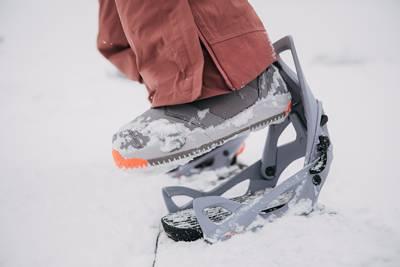
Good to know:
Many rear-entry bindings are actually double-entry front/rear bindings. You can also fit them from the front and adjust the straps optimally.
The Step-On revolution
The latest arrival on the market, the Burton Step-on technology revolutionizes snowboard bindings with a new system that makes it possible to do without straps while retaining all the necessary responsiveness and control. Since 2017, Burton offers a system that locks the boot into the binding via a mortise and tenon system, i.e. via small parts on the bindings on which the boots are wedged. Much lighter and more comfortable while remaining reliable and efficient, the only drawback of this fastening system is that it can only be used with Burton Step-On boots.
How to choose your fast snowboard binding?
If you have decided to go for a quick binding system, the questions to ask yourself about which model to choose are the same as for a classic binding. First of all you need to evaluate your level of practice, to find a binding that will give you pleasure and won't put you in trouble. However, you should also think about your riding style, what you like to do with a snowboard under your feet. Are you rather a fan of curving and carving on packed snow, a freestyle genius whose favourite terrain is the snowpark, or an off-piste enthusiast who goes off the beaten track to find his own space of expression? It is these combined parameters, level and program, that will be the main criteria for your choice of binding.
To help you in your choice, we propose a classification of bindings by level (beginner - intermediate, intermediate - confirmed, confirmed - expert) and by program (freestyle, freeride, polyvalent freestyle, polyvalent freeride).

